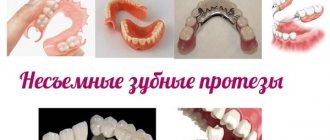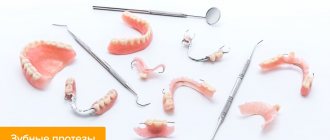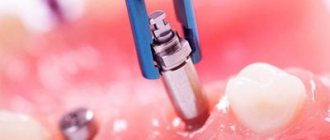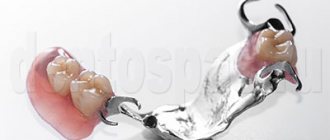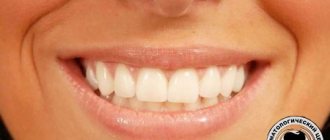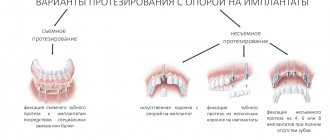HomeOrthopedic dentistry PROSTHESIS ON IMPLANTS
"BIONIC DENTIS" EXPERT CLINIC - WE WILL INSTALL PROSTHESES ON IMPLANTS OF ANY MODIFICATION.
IN THE PHOTO: TOTAL PROSTHETICS USING PROSTHETICS ON IMPLANTS. IMPLANTOLOGIST-ORTHOPEDIST OZEROV PETER VLADIMIROVICH
On this page you can choose any prosthesis on implants from the 4 presented varieties. These are the best modifications of a modern prosthesis without a palate:
- Removable denture on MINI IMPLANTS
- Removable denture on implants LOCATOR
- Fixed prosthesis on implants “ALL-ON-4”
- Fixed prosthesis on VSE-NA-6 implants
We will tell you about each modification of these new generation orthopedic products, and give clear recommendations on choosing a prosthesis for the patient. Information on the price of prosthetics on implants, their pros and cons, photos of patients Before and After prosthetics on implants on this page.
IN THE PHOTO: TOTAL PROSTHETICS USING PROSTHETICS ON IMPLANTS. IMPLANTOLOGIST-ORTHOPEDIST OZEROV PETER VLADIMIROVICH
What is implant prosthetics?
There are many methods for restoring teeth in dentistry.
Each of them has its advantages and helps solve a specific problem. However, implant prosthetics are considered the most effective. The basis of the method is the implantation of titanium pins into the jawbone, which replace the roots of natural teeth. An orthopedic structure is installed on top of the pin, depending on the condition of the dentition.
The technology is applicable to restore one tooth, several dental units in a row, or the entire jaw at once. In the first case, an artificial crown is fixed on the implant, a bridge structure is used to replace 2-3 teeth, and when all teeth are restored, a fixed or removable prosthesis is used. The doctor selects the material for the orthopedic design based on the method of installing the prosthesis, the preferences and financial capabilities of the patient.
Types of prosthetics:
- Classic dental implantation. Suitable for cases where 1-2 teeth from a row are missing. Can be with delayed or immediate loading, with installation in one or more stages.
- All teeth in 1 day. It is used in cases of complete edentia (loss of teeth). Offers several solutions, depending on the structure of the jaw and the condition of the bone tissue. This can be the installation of All-on-4, All-on-6 protocols or simultaneous implantation.
Bridge prosthetics
This technology involves almost the same processes that are typical for installing a conventional bridge. The only difference is that fewer implants act as support than natural teeth. The number of implants that need to be installed varies depending on the size of the dentition defect. Considering the strength of the implant-bone connection, two implants can serve as a support for 3 crowns. However, prosthetic plans are always calculated based on the individual characteristics of the patient.
Pros of technology
Some will say that dental implantation is very expensive. But if you evaluate the result in perspective, it turns out that this is a profitable investment in your own health for the next 20-25 years.
Judge for yourself: the service life of prostheses on implants is 2-3 times longer than traditional designs. And the titanium pin ensures an even load on the jaw, while maintaining chewing and speech functions.
In addition, the use of implants when installing dentures allows you to restore any number of teeth, regardless of their location in the oral cavity.
In case of edentia (complete absence of teeth), implants can be used to place not only a removable, but also a permanent orthopedic structure, which in its properties is much more convenient and reliable.
An even load on the upper and lower jaw eliminates bone tissue atrophy and subsequent problems with natural teeth. In addition, implant prosthetics do not use healthy teeth. Nothing is attached to them; natural teeth do not need to be ground down, which significantly extends their life.
Dentures are comfortable to wear: they do not injure the gums, do not distort diction, and do not shift under load.
But the main advantage is the high level of aesthetics. All types of dentures installed on implants look like real teeth.
Advantages of dentures on implants
- No need to grind down healthy teeth
- Lifetime service life (the crown part can be replaced if necessary)
- Complete restoration of chewing function (without restrictions)
- High aesthetics
- Easy hygienic care
6 stages of prosthetics using classical implantation
1 Diagnostics
Assessing the characteristics of a clinical case, identifying indications and contraindications for implantation. Determining the relevance of osteoplasty
2 Preparatory
Sanitation of the oral cavity. Osteoplasty – if necessary
3 Implantation
Surgery to install a titanium root into the patient's jaw bone tissue
4 Osseointegration
Period of implantation
5 Preparation for prosthetics
Installation of abutment and healing abutment
6 Dentures
Fixation of permanent dentures
Types of prostheses on implants
In general, implant-supported prostheses are divided into two types:
- Removable.
- Fixed.
The first type differs significantly from analogues of classical prosthetics. Traditional structures are fixed exclusively on the gums, or attached to supporting teeth. Thanks to implants, removable dentures are securely fixed in the jawbone, but they can be removed if necessary. That's why they are called conditionally removable.
Fixed dentures are considered a more durable and optimal option for dental restoration. In addition to the artificial crown, some types of structures are equipped with a base made of elastic plastic, which imitates natural gums.
Fixed dentures can be used to replace any number of teeth, even if they are located in different parts of the dentition. We will talk in more detail about each type of prosthesis a little later.
There are also temporary dentures that are installed during the period of fusion of the implants with the jawbone. They maintain the aesthetics of the dentition and reduce the mechanical load on the pins, speeding up the healing process.
Temporary dentures look like removable structures that hook onto supporting healthy teeth using hooks. The most common option is a butterfly-shaped prosthesis. It is equipped with a plastic gum and two plastic holders for adjacent teeth. A denture replaces one or more teeth in a row.
Installation steps
The reliability of implant-supported dentures directly depends on the location of fixation. Especially when it comes to restoring all teeth. Correct placement of implants will ensure uniform distribution of chewing load on the jaw and allow the use of a minimum number of pins. This reduces the recovery period and the degree of surgical intervention during installation.
At the initial stage, the implantologist performs an initial examination of the oral cavity. In EspaDent clinics, to select a prosthetic method, additional diagnostics are carried out using a modern Orthophos SL 3D tomograph, which takes three-dimensional, layer-by-layer images of both jaws. Professional equipment allows you to simulate the treatment process and show the patient the final result.
In the absence of contraindications, the doctor proceeds to the next stage of prosthetics on implants - fixation of titanium pins in the jawbone. The procedure takes 40-60 minutes for each implant. It is carried out using anesthesia. Our specialists use safe painkillers. They are non-toxic and do not cause allergic reactions.
The pin fixation process includes:
- Gum section.
- Preparing the space in the jawbone.
- Implant installation.
- Gum stitching.
The period of fusion of the pin with the bone tissue takes 3-4 months. During this time, the patient is fitted with temporary removable dentures, which we discussed above.
After the healing process is completed, the doctor installs a gum former and takes an impression of the teeth. After a couple of days, the adapter is replaced with an abutment, on which the finished denture is fixed.
Advantages of full implantation in terms of ease of eating
If we compare chewing efficiency with classic removable prosthetics and with implant-supported prosthetics, in the latter case it increases significantly, and, as is known, the quality of chewing food affects the condition of the gastrointestinal tract and the body as a whole. Owners of complete removable dentures have to regularly contact a gastroenterologist, who can only offer them to put food through a blender, but any person wants to eat well.
It is also worth noting that often the process of chewing with the help of a complete removable denture constantly causes pain, since the structure puts pressure on the mucous membrane, under which there is also the periosteum with many nerve endings. When the denture is installed supported by implants, there is no pain, since there is no pressure on the soft tissues.
Before and after full dental implantation. Works by P. A. Zotov
How long does implant prosthetics take?
The duration of installation of prostheses on implants depends on the clinical situation. After performing a tomography of the jaw, the doctor assesses the condition of the bone tissue. Depending on the degree of jawbone atrophy, the implantologist may prescribe an osteoplasty procedure.
The period of prosthetics on implants is determined by the rate of bone tissue regeneration, as well as the chosen installation technique. For example, the healing period of implants in the upper jaw takes, on average, 3-4 months. For the lower jaw a little less - 2-3 months.
If a procedure is carried out to restore bone tissue due to atrophy, then another 2-4 weeks are added to the installation of prostheses.
WE MANUFACT ANY IMPLANT PROSTHESES PRESENTED ACCORDING TO THE STANDARDS OF THE RF MINISTRY OF HEALTH
In Moscow and the Moscow region, many dentists offer their services for the manufacture of dentures on implants of one modification or another. How can a patient choose a performer for such complex prosthetics? It is necessary to focus on prostheses manufactured according to the STANDARD OF THE RF MINISTRY OF HEALTH. This industry standard regulates all aspects of the production of orthopedic structures:
- the requirements for the sanitary and epidemiological regime in a medical institution for such types of work have been determined
- a list of equipment and space for performing these services has been determined
- requirements for personnel qualifications have been determined.
- methods of prosthetics and implantation have been determined that should be strictly followed
- safety requirements for materials used for prosthetics and implantation have been determined.
IN THE PHOTO: TOTAL PROSTHETICS USING PROSTHETICS ON IMPLANTS. IMPLANTOLOGIST-ORTHOPEDIST OZEROV PETER VLADIMIROVICH
The dental clinic "Bionic Dentis" strictly follows the STANDARD OF THE MINISTRY OF HEALTH OF THE RF when carrying out work on prosthetics on implants.
- The clinic uses a strict sterilization and disinfection protocol, which eliminates infection of our patients and the occurrence of purulent-inflammatory complications after medical intervention.
- Surgeries at the clinic are performed in an operating room rather than in a regular dentist's office.
- all prosthetic and implantation methods are registered with the Ministry of Health of the Russian Federation
- all materials used for prosthetics have a registration certificate from Roszdravnadzor of the Russian Federation
- Thanks to close cooperation with the implant manufacturer Nobel Biocare, we install only original implants, the authenticity of which is confirmed by an international certificate.
- The work is carried out only by qualified and certified dentists, whose certificates you can view in the clinic or on our website in the ABOUT DOCTORS section
- All work is provided with a long warranty period.
- The warranty on Nobel Bioker implants is international for life.
IN THE PHOTO: TOTAL PROSTHETICS USING PROSTHETICS ON IMPLANTS. IMPLANTOLOGIST-ORTHOPEDIST OZEROV PETER VLADIMIROVICH
Our clinic is your reliable and qualified partner in the field of prosthetics on implants and installation of prostheses on implants of any modification.
Over the years, we have accumulated one of the largest clinical experiences in the Russian Federation and have honed our methods to perfection.
Following the STANDARD OF THE MINISTRY OF HEALTH OF THE RF in services and work on prosthetics and implantation allows us to produce structures of the highest quality that last for decades.
We invite you to get acquainted with our clinic and doctors, see with your own eyes and be convinced that our dentistry is rightfully recognized as one of the best clinics in Moscow and the Moscow region.
Prosthetics using removable structures
When is it advisable to use removable dentures on implants? Often the argument is limited budget. Removable structures are much cheaper than permanent ones, especially in the case of complete edentia.
The method is effective for severe atrophy of the jaw bone, if the patient is not ready to undergo a sinus lift of the jaw. A denture with artificial gum will hide imperfections in the contour of your own tissues.
Conditionally removable structures are fixed to implants in two ways: screw or beam. In the second case, a metal structure in the form of a beam is used, on which artificial teeth are installed. The beam serves as the base of the prosthesis and ensures uniform distribution of mechanical load on the bone. Due to the single design, the prosthesis is more stable.
Both options for fixing the prosthesis can be removed if necessary (for cleaning, etc.). However, only a dentist should do this.
What is the difference between classic removable dentures and those installed on implants? The design with pins is smaller in size and has better fixation in the oral cavity, which ensures comfortable wearing.
The absence of a palate in the prosthesis preserves taste sensitivity when eating food, without any restrictions.
The ability to remove the prosthesis extends its service life and allows for timely cleaning and replacement of elements, if necessary.
Lower cost makes this type of implant prosthetics accessible to most patients.
If we talk about size, fixed dentures are more neat and compact. From an aesthetic point of view, removable ones are also inferior to non-removable ones. The latter do not have artificial gums.
To make crowns in removable dentures, the following is used:
- Plastic (for temporary fixation).
- Ceramics.
- Zirconium dioxide.
All materials have increased strength and high aesthetics. At EspaDent clinics, crowns are made using digital CAD/CAM technology. The automatic production mode eliminates the occurrence of errors associated with the human factor. Dentures take into account the anatomical structure of the patient’s jaw and the location of adjacent teeth. Their installation does not change the bite, does not deform the masticatory muscles, and does not cause facial asymmetry.
Prosthetic options for implantation
Removable. Suitable for patients who wore a removable denture before implantation. First, the removable structure must be adapted for installation on implants. To do this, special ball-shaped latches (attachments) are attached to it in a dental laboratory. This option allows the patient to reduce the cost of making a new prosthesis.
Removable prosthetics on implants are used at the transitional stage before installing a permanent prosthesis.
Fixed and conditionally removable. In 99% of cases, permanent orthopedic structures are placed on implants. They are secured with special screws through holes in the artificial teeth. Conditionally removable products can only be removed by a doctor in the clinic.
Temporary. In order not to overload the implants during healing, they are prosthetized with lightweight temporary structures with plastic teeth. Temporary dentures are used for simultaneous implantation of the smile area and dental technology in 1 day.
Permanent. It is separated into a separate stage of treatment and is carried out 4-6 months after the installation of the pins. Permanent fixed dentures on implants with teeth made of metal ceramics or zirconium dioxide last more than 10 years.
An orthopedic doctor compares different options for prosthetics on implants
Fixed structures
As a rule, crowns or bridges are used for permanent dental prosthetics on implants. A single denture most accurately replicates the shape and appearance of the missing tooth. Using single crowns, the implantologist corrects the gum contour, making it almost ideal. This is especially true for the front teeth that fall into the smile zone.
A bridge structure is used to restore several teeth. It is necessary in cases where it is not possible to install 2-3 implants in a row due to lack of space.
The difference from a traditional bridge lies in the method of fastening. The structure receives additional support in the form of pins and does not affect adjacent healthy teeth. In other words, there is no need to grind down your natural teeth and attach a prosthesis to them.
The advantages of the technique include the maximum degree of stabilization of the prosthesis, high aesthetics and a tight fit of the structure to the gum, which eliminates its damage and the ingress of food debris into the prosthesis.
The only disadvantage of fixed dentures on implants is the price. But in fact, this is the most profitable investment in your own health. The durability of the implants and the lifetime guarantee for their installation only confirms the quality of the technique.
Restoration of teeth with complete edentia
The method of fixed prosthetics effectively copes with the problem of complete absence of teeth. For example, All-on-4, All-on-6 protocols or simultaneous implantation.
The All-on-4 protocol involves the installation of four implants in the jaw: two in the frontal part, two on the sides, at an angle of 45 degrees.
The technology provides instant chewing load, immediately after fixing the prosthesis. Installation of the prosthesis is possible immediately after implantation.
If the patient has severe jawbone atrophy, the All-on-6 protocol is used. An additional number of implants ensures reliable fixation of the prosthesis even with insufficient bone tissue.
But be careful! Due to the popularity of the technology, many fakes have appeared. Poor quality materials and unprofessional work can lead to serious health complications and loss of money.
EspaDent is an official partner of Nobel Biocare, a leader in implantology and developer of protocols for dental restoration in 1 day.
In 2016, with the support of Nobel Biocare, our clinic created its own Center for implantation and complete dental prosthetics, which provides training to specialists from all regions of Russia.
Implantation in the absence of teeth - how many implants are needed?
The maximum implantation of teeth in the lower jaw, as well as in the upper jaw, is carried out with the installation of up to 14 implants, on each of which a separate crown is fixed - that is, a complete dentition is recreated, not counting wisdom teeth. But this method is not suitable for all patients, since it requires a sufficient volume of bone tissue, and restrictions may also arise due to the proximity of nerves. In addition, installing 28 implants on both jaws using the same number of crowns is a rather expensive procedure, which is not always justified. As for the minimum number of implants, there can be only 8 of them - four on each jaw. This technique is also called “all-on-four implantation.” However, to achieve optimal results, experts recommend 12 - six on each jaw.
Materials for dentures
To attach prostheses to implants, the material must be highly durable or have a metal base. This is necessary for the structure to withstand the load of the abutment (adapter).
Crowns for fixed structures are made from metal-ceramics, composite, metal-plastic, and also from zirconium dioxide. The prosthesis is attached using cement or screws.
Composite crowns for implants with a metal frame are used for single replacements, as well as for the installation of bridges. The design has a long service life (10-12 years) and is subject to repair. Reliable, lightweight, with a high degree of aesthetics, composite crowns are comfortable to wear and look like real teeth.
Plastic removable dentures last no more than 5 years and are used only for temporary or adaptive prosthetics. At EspaDent clinics, our specialists use more technologically advanced plastic for temporary prostheses. The composition contains crushed diamond chips, which makes the structure more resistant to stress during the fusion of the implant with the bone.
Fixed prosthesis is made of zirconium or metal ceramics. This is due to the high reliability of the design. Crowns for implants cannot be restored, as is the case with composite ones, so they must be as strong and durable as possible. For metal-ceramics, the service life is 8-10 years, and zirconium is a little longer - 15-17 years.
The disadvantages include the imperfect aesthetics of ceramic crowns - the metal base can be visible in the light. Therefore, it is better to use them to restore lateral teeth.
Zirconium dioxide crowns have almost no disadvantages. Decent service life, impeccable appearance, increased material strength, absence of allergic reactions even in patients with high sensitivity. Of course, such prostheses are more expensive than their analogues.
Reviews of doctors providing the service - Prosthetics on implants
Sincere gratitude to the dentist Mikhail Ivanovich Fedoseev!
Thanks for the impeccable work! Mirkerimov F.S. 08/15/2017 Read full review Mirkerimov F.S.
15.08.2017
Together with my husband, we have been treating our teeth in the dental department of the CELT clinic for more than 10 years. The time has come to place implants, and on the advice of our general practitioner Natalya Olegovna Elizarova, I turned to surgeon Evgeniy Borisovich Antyukhin. Despite his youth, the doctor has extensive experience in… Read full review
Olga
30.05.2017
Contraindications
It is obvious that implant prosthetics is a complex and expensive procedure. Therefore, even at the initial stage, it is important to eliminate all possible risks for the patient.
The reason for refusal or delayed treatment may be jaw deformation, pathological atrophy of bone tissue, bruxism, increased tooth wear, and malocclusion. Contraindications to surgery are also diseases of the nervous system, bleeding disorders, reduced immunity, intolerance to painkillers, and the presence of tumors.
Care instructions
In order for implant-supported dentures to last as long as possible, they require careful care. Each patient receives written information about how to care for fixed or removable dentures after the procedure.
Special toothpastes and brushes are used to clean dentures. It is easier to take care of removable structures, because... You can easily remove the prosthesis. For this purpose, it is recommended to visit the dentist's office, who will professionally clean the dentures.
To remove food debris from interdental crevices and hard-to-reach places in the structure, you need to use dental floss, brushes and irrigators.
Remember, proper care of the prosthesis and careful use significantly extends its service life.
How serious is the gag reflex problem when wearing a classic removable denture?
The gag reflex occurs quite often when using complete removable dentures. Moreover, there are no methods to help rid a patient of it, because this is, in fact, an individual reaction of the body. The fact is that such dentures on the upper jaw must end at the so-called line A, where the hard palate meets the soft palate, otherwise they will not hold. Often, a gag reflex can occur even when taking impressions. In order to carry out the procedure, the doctor has to prescribe the person sedatives or even sedation. But if the patient cannot endure the procedure of taking impressions without discomfort, a reasonable question arises: how will he cope with wearing the prosthesis itself?
What is the cost in Moscow?
The pricing of the procedure is influenced by a number of factors:
- Difficult to install.
- Type of construction.
- Materials used.
- Qualification of the implantologist and rating of the clinic.
On average, high-quality installation of a prosthesis on an implant starts from 25,000 rubles. If you need to replace a large number of teeth or the entire jaw, then it is wise to choose the turnkey option. For example, All-on-4 or All-on-6 protocols. The price already includes all stages of the procedure and the material of the prosthesis. In terms of dental unit, it turns out to be more profitable than installing point implants or bridges.
In addition, these protocols ensure fixation of prostheses immediately after implantation of the pin. Those. tooth restoration will take 1-3 days, without a long adaptation period, with the ability to load the prosthesis immediately after surgery.
Advantages of our clinic
EspaDent dental clinics work only with trusted manufacturers, experts in the field of implantology: Nobel Biocare (Switzerland), Cortex (Israel), Noris Medical (Israel).
Primary diagnosis is carried out using professional equipment - an Orthophos SL 3D dental tomograph, which allows you to obtain volumetric layer-by-layer images of the jaw and carry out precise treatment planning.
In the clinic’s own laboratory, our specialists will make a prosthesis in just 1 day and fix it immediately after installing the implants. Or, maximum, within 72 hours.
The technology for installing a fixed prosthesis is low-traumatic and is carried out using local anesthesia. This significantly shortens the rehabilitation period.
A large selection of implants allows you to install a prosthesis within your financial capabilities, without loss of quality. The presence of various form factors of structures will ensure fixation of a fixed prosthesis even with bone tissue atrophy.

